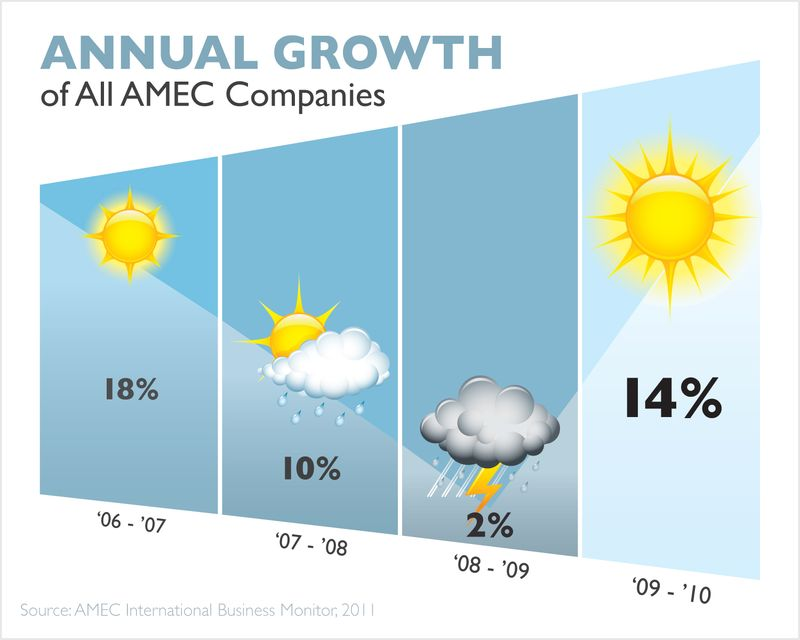Back in 2009, PR measurement professionals were cautious, to say the least.
Fifty-four percent of AMEC (The International Association of Measurement and Evaluation of Communications) members were worried about the health of the industry, predicting worsening market conditions. So it’s great news that this week the same membership has reported a 14% growth in revenues during the previous 12 months.
And the good news didn’t stop there. Over three quarters of AMEC members said they expected the industry to continue to improve in the coming year.
Members of the PR measurement trade association also found that more and more clients were waking up to media analysis metrics and how these could be linked to business goals and outcomes, opposed to simply looking at outputs. However, whilst the majority of AMEC members said that clients often talk about return on investment, they were struggling with ways to measure it effectively.
Balancing the positive news of growth is the cold reality that 59% of the AMEC members also said that they expected the dreaded AVE (advertising value equivalent) to remain a significant element in measurement programs for the foreseeable future.
This, despite the great work of AMEC and IPR in declaring that “AVE’s are not the value of Public Relations” in the Barcelona Principles last year.
The two sides of a juxtaposed position were neatly demonstrated over on Ragan’s PR Daily where Jessica Epperly, a PR consultant, wrote a piece that appeared to endorse AVE’s, only for the comments field to be inundated with the great and the good of the measurement profession (yet again) explaining why it is a flawed metric. (and as Shonali wrote about here on Waxing UnLyrical as well.)
The education challenge that the evaluation industry faces continues to be significant.
We need to broaden the debate on from an internal one amongst the evaluators and the enlightened PR professionals to a far broader audience that encompasses all PR practitioners.
After all, as long as there is a demand for the metric, it is bound to remain commercially available on the market.
Moving back to the industry’s desire to link business objectives to PR metrics brings us to social media evaluation.
As the industry has started to embrace more credible and meaningful metrics, social media has presented many more challenges. In the rush to measure the medium, software companies have released tools claiming to analyze influence and impact and measure “value,” even trying to assign value in $$ terms to a Facebook fan.
Just as in traditional PR measurement AVE’s and inflexible scoring systems are flawed, so too are these one-size-fits-all approaches to social media measurement.
The good news is that at the next European Summit on Measurement in Lisbon this June, I will be joining Tim Marklein, Weber Shandwick’s Executive VP of Measurement and Strategy, and Katie Paine of KD Paine and Partners, hosting a workshop on moving the industry towards global standards on social media measurement.
The importance of this topic cannot be over-emphasized. This is your chance to join the debate and help us to shape the credible metrics of the future. We will be looking for your contribution to the debate both via online channels for those who cannot attend, and in person at the event.
Will you help us? Your industry needs you, after all.
Top image: Bain McLeod via Flickr, CC 2.0; AMEC graphic used with permission
 Richard Bagnall is Metrica‘s Managing Director and has been working in public relations for over two decades. Prior to Metrica, he worked at Saatchi and Saatchi and The Rowland Company before going in-house at the Royal College of General Practitioners. Richard joined Metrica in 1996 and has since built the business into an award winning, world leader in PR measurement.
Richard Bagnall is Metrica‘s Managing Director and has been working in public relations for over two decades. Prior to Metrica, he worked at Saatchi and Saatchi and The Rowland Company before going in-house at the Royal College of General Practitioners. Richard joined Metrica in 1996 and has since built the business into an award winning, world leader in PR measurement.





![[EVENT]: PR Hacks for Small Biz (online)](https://shonaliburke.com/wp-content/uploads/2021/06/FB-Ad-1200x800-01-01-01-Copy-500x383.jpeg)





[…] disciplines who are adept at correlating content with sales and that holy grail: ROI. According to Bagnall (2011) social media presents a challenge to an industry which has just started to embrace more […]
[…] PR & Social Media Measurement: A Bright Outlook […]
Hi thanks for your kind words. The secret to correctly valuing the data is to make sure that you are looking at data that is relevant to your objectives. Organisations’ objectives will vary of course depending what sector they are in and what they are trying to achieve. To have a suiote of valid / recomended metrics from which these sharp people can pull seems to me to be the sensible approach. There is no one size fits all in social media measurement, and certainly not one that makes sense. I totally agree with your point about mioving beyond just looking at social media communication. We’re keen to bring other organisations to the table to help us shape not only the sensible metrics that the industry needs, but also to cover off other disciplines like word of mouth (WOMMA) for example. We’re hoping that the work at AMEC’s conference in June will be just the first step on this journey. Richard.
Richard thanks for the informative post. As with everything in business until we have official standards various forces will push and pull over what metrics are important and how to interpret them. The good news it it gives sharp people and businesses an advantage if they can correctly value and use the data as a competitive advantage.
The biggest issue i have is the small sliver of human communication (social media) we are monitoring and making lots of hypothesis from this (even with traditional media measuring this occurs). And to really crank up the heat we must force our clients to put values on things (or help us) vs allowing these rogue elements promote false prophets on the false prophet hosting site Mashable and other outlets that cloud the real work and value of all this.